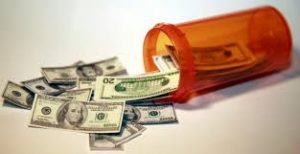
In an Oct. 5 report, The Wall Street Journal noted that prices for the 30 best-selling drugs last year had gone up an average of 76 percent since 2010 – eight times faster than general inflation.
Indianapolis Business Journal (IN)
Consumers aren’t the only ones getting hit with high drug prices.
Several health insurance plans and employers in Indiana have seen their spending on prescription drugs spike this year as more patients use new drugs with sky-high prices for hepatitis C, cancer and other ailments.
A 12-week course of treatment of hepatitis C medicines Sovaldi or Harvoni cures many patients of their disease. But the retail price of that treatment is substantial – about $84,000 for Sovaldi and $113,000 for Harvoni.
“Some of the new drugs, the biopharmaceuticals that have hit the market in the last year, are much costlier than a lot of us thought they would be,” said Cesar Martinez, CEO of Indianapolis-based health insurer MDwise Inc. “They’re healing people, but the unit cost is just higher than we anticipated.”
On top of that, drugmakers have been aggressively hiking prices, even on older drugs. In an Oct. 5 report, The Wall Street Journal noted that prices for the 30 best-selling drugs last year had gone up an average of 76 percent since 2010 – eight times faster than general inflation.
MDwise Inc. saw its spending on prescription drugs rise 451 percent in the first half of the year, compared with the first half of 2014. According to MDwise’s second-quarter financial report, it spent $31.9 million on prescription drugs this year, up from $5.8 million at the same point last year.
Meanwhile, MDwise’s premiums in the first half of the year rose only 16.3 percent.
MDwise will adjust its actuarial predictions for next year, and try to pass on those costs to its main customer, the state of Indiana and its Medicaid program. But for this year, it just has to eat the losses.
Health plans don’t have to cover all approved drugs and, even if they do, they can make some drugs more expensive to patients by requiring higher co-pays. But the Indiana Medicaid program typically covers all drugs approved by the U.S. Food and Drug Administration and, rather than making some drugs more costly, instead just requires prior authorization before a patient can fill a prescription.
Managed Health Services, a unit of St. Louis-based Centene Corp. that serves Indiana Medicaid beneficiaries, saw its prescription-drug spending jump 24 percent in the first half of this year, compared with the same period last year, even though its premiums fell 5 percent.
But Indianapolis-based Advantage Health Solutions, which does not provide benefits to Medicaid patients, saw only a 3.6 percent increase in prescription costs, to $29.5 million. Meanwhile, premiums rose 10.3 percent.
Indianapolis-based Anthem Blue Cross and Blue Shield is a hybrid. It sells commercial insurance as well as serving Medicaid beneficiaries.
Anthem spent nearly $35 million more on prescription drugs during the first half of this year compared with the first half of last year, according to its second-quarter financial report. That’s up nearly 10 percent over the same period last year, even though Anthem’s premiums rose only 4 percent.
Many of the new drugs are priced to be slightly less costly than the medical treatments that existed before. Sovaldi and Harvoni can spare patients from needing a second liver transplant, which comes with exorbitant costs.
In addition, the new cancer drugs can replace a variety of health care services – surgery, chemotherapy, anti-nausea medicines, hospital stays – that can easily top $100,000 in a year.
The trouble is, said MDwise’s Martinez, more people can take drugs than can get new organs or receive surgery.
“We’re starting to see an uptick in patients getting those prescriptions,” he said. “Obviously, it’s much easier to take a [drug] than to get cut and go under a major surgery. Patients may be too frail or elderly to get a transplant, but can take the [drug].”

